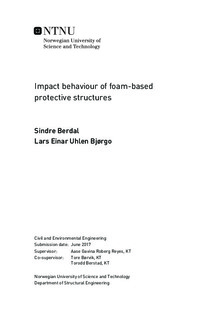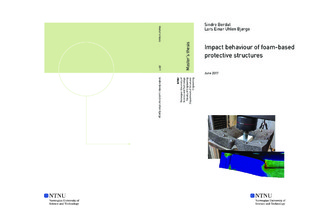| dc.contributor.advisor | Reyes, Aase Gavina Roberg | |
| dc.contributor.advisor | Børvik, Tore | |
| dc.contributor.advisor | Berstad, Torodd | |
| dc.contributor.author | Berdal, Sindre | |
| dc.contributor.author | Bjørgo, Lars Einar Uhlen | |
| dc.date.accessioned | 2019-09-11T08:35:02Z | |
| dc.date.created | 2017-06-09 | |
| dc.date.issued | 2017 | |
| dc.identifier | ntnudaim:17672 | |
| dc.identifier.uri | http://hdl.handle.net/11250/2614909 | |
| dc.description.abstract | Foams are three dimensional cellular materials, with cell walls made up of a solid or liquid material and cells containing a gas or liquid. The solid material can be anything from a metal to a ceramic. Metallic and polymeric foams are used to protect engineering structures, due to the high energy absorption and low weight. Foam can be used as a sacrificial cladding to protect buildings from blast and impact, or in car parts to protect humans both inside and outside the car. To be able to predict the behaviour of the foam, it is important to develop accurate and reliable numerical models.
The main objective of the present work was to investigate the impact behaviour of foam-based protective structures and whether the response can be predicted using computational tools. Material tests with the polymeric foams EPP and XPS were conducted at different strain rates. Both quasi-static and dynamic component tests were performed to study the behaviour of the foams. The components consisted of a foam core with steel skins on one or both sides. Numerical analyses were conducted to investigate the predictive capabilities of the numerical models. The results were used to study how the components may be optimized with respect to energy absorption.
The overall observation from this research is that the numerical simulations were able to predict the experimental results with reasonable accuracy. Both numerical and experimental results suggest that low density foams are preferable if minimum force and deflection of the back plate are the design criteria. The optimization tool LS-Opt was used to find an optimal density with respect to energy absorption. Findings indicate that the design of sandwich structures greatly depend on the input parameters e.g. impact velocity. | en |
| dc.language | eng | |
| dc.publisher | NTNU | |
| dc.subject | Produktutvikling og produksjon, Industriell mekanikk | en |
| dc.subject | Bygg- og miljøteknikk, Beregningsmekanikk | en |
| dc.title | Impact behaviour of foam-based protective structures | en |
| dc.type | Master thesis | en |
| dc.source.pagenumber | 169 | |
| dc.contributor.department | Norges teknisk-naturvitenskapelige universitet, Fakultet for ingeniørvitenskap,Institutt for konstruksjonsteknikk | nb_NO |
| dc.date.embargoenddate | 2020-06-09 | |

